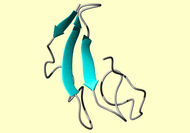
NMR Restraints Grid

 |
NMR Restraints Grid |
 |
Result table
| image | mrblock_id | pdb_id | bmrb_id | cing | stage | position | type |
|
|
3936 |
1egf |
2201 | cing | 1-original | 2 | comment |
___________________________________________________________________________ The pseudo-atom (QA, QB, QG, QE, QQG, QQD, CG1, and CZ4) names are those described in Wuethrich, et al.[J. Mol. Biol.169: 949(1983)]. The side-chain amide protons (HDE, HDZ in Asn and HEE, HEZ in Gln) have been individually assigned. Each upper-bound constraint includes a brief comment(#)indicating the magnitude of the pseudo-atom correction factor which has been added to the value determined from the scheme outlined in Table I of the article cited in the JRNL entry. The basis for these values (i,g,m,r,q corresponding to 0.6,0.7,1.0,2.0,and 2.4 angstroms)is described in Wuethrich, et al.[J. Mol. Biol. 169: 949(1983)]. Additional comments are: da-degenerate alpha proton resonances, NOE intensity divided by two; db-degenerate beta proton resonances, NOE intensity divided by two; dg-degenerate gamma proton resonances, NOE intensity divided by two; dd-degenerate delta proton resonances, NOE intensity divided by two; de-degenerate epsilon proton resonances, NOE intensity divided by two; Me-methyl protons, NOE intensity divided by three; BOTH-both NOESY crosspeaks between a given proton and the two protons of a single methylene could be established quantitatively, and both upper-bound constraints were assigned to the larger of the two corresponding distances; SS-CONSTR - disulfide constraint; H-BOND - hydrogen-bond constraint. The NOE-derived upperbound distance constraints were derived from three NOESY spectra: 65 ms mixing time in H2O (65 MS H2O); 100 ms mixing time in D2O (100 MS H2O); and 250 ms mixing time in D2O (250 ms D2O). Additional NOE-derived constraints which were derived from carefully baseline-corrected 65 ms mixing time data are indicated as 65 MS H2O LP (low plotting). Table II. Lower-bound Constraint List Murine Epidermal Growth Factor pH: 3.1, Temp: 28 deg
Contact the webmaster for help, if required. Sunday, May 5, 2024 10:26:26 AM GMT (wattos1)